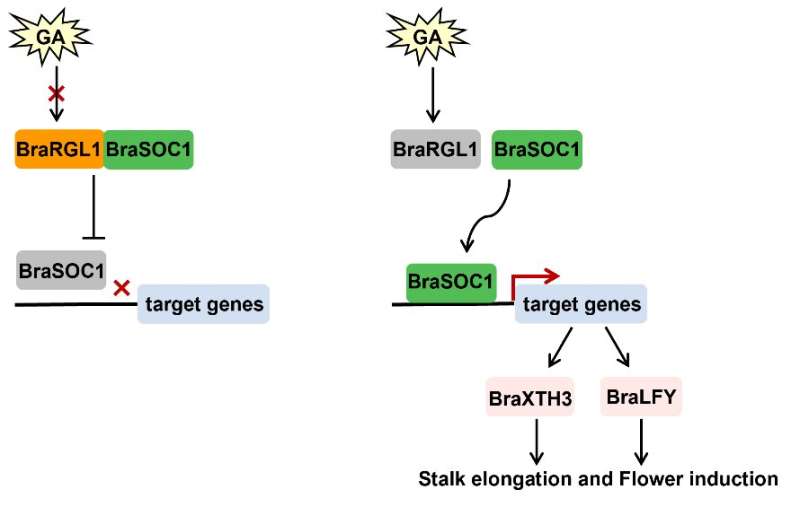This article has been reviewed according to Science X's editorial process and policies. Editors have highlighted the following attributes while ensuring the content's credibility:
fact-checked
trusted source
proofread
Study explores role of BraRGL1 in regulation of Brassica rapa bolting and flowering

In June 2023, Prof. Riyuan Chen's team of South China Agricultural University published a research article entitled "Role of BraRGL1 in regulation of Brassica rapa bolting and flowering" in Horticulture Research.
In this study, the authors performed highly efficient and inheritable mutagenesis using the CRISPR/Cas9 genome editing system in BraPDS (phytoene desaturase) and BraRGL1 (key DELLA protein) genes. The flower bud differentiation and bolting time of BraRGL1 loss-of-function mutants were significantly advanced.
The expression of GA-regulatory protein (BraGASA6), flowering-related genes (BraSOC1, BraLFY), expansion protein (BraEXPA11) and xyloglucan endotransferase (BraXTH3) genes was also significantly upregulated in these mutants. BraRGL1 overexpression lines displayed contrasting phenotypes. BraRGL1 mutants were more sensitive to GA signaling. BraRGL1 interacted with BraSOC1, and the interaction intensity decreased after GA3 treatment.
In addition, BraRGL1 inhibited the transcription-activation ability of BraSOC1 for BraXTH3 and BraLFY genes, but the presence of GA3 enhanced the activation ability of BraSOC1, suggesting that the BraRGL1-BraSOC1 module regulates bolting and flowering of Brassica rapa through GA signal transduction. Thus, the researchers hypothesized that BraRGL1 is degraded, and BraSOC1 is released in the presence of GA3, which promotes the expression of BraXTH3 and BraLFY, thereby inducing stalk development in Brassica rapa.
Further, the BraRGL1-M mutant promoted the flower bud differentiation without affecting the stalk quality. Thus, BraRGL1 can serve as a valuable target for the molecular breeding of early maturing varieties, which provides a scientific basis for the further application of breeding strategies to control this important trait.
Professor Riyuan Chen, Professor Shiwei Song and Assistant Professor Wei Su from the College of Horticulture, South China Agricultural University, are the paper's co-corresponding authors. Ph.D. Yudan Wang is the first author of the article. In recent years, Professor Chen Riyuan's team has achieved a lot of research progress in stem development, flower bud differentiation, and nutrient regulation of Caixin.
More information: Yudan Wang et al, Role of BraRGL1 in regulation of Brassica rapa bolting and flowering, Horticulture Research (2023). DOI: 10.1093/hr/uhad119
Provided by NanJing Agricultural University




















